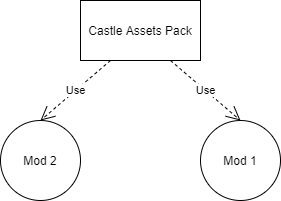Mod Dependencies
< HPL3
Jump to navigation
Jump to search
Mod dependencies provide a solution sharing mod content across multiple other mods. A few mods could depend on a parent mod to derive assets and other content from, instead of including it in their own mod.
Contents
When to Use Mod Dependencies
- The main occasion to use Mod Dependencies is when you want to distribute assets packs which include models, textures, materials, scripts, etc for people to use freely in their own mods.
- Mod dependencies can help to reduce the mod size you want to distribute, as a big portion of the assets themselves are not actually included in the mod, but come from an external source.
Setting Up a Mod Dependency
In order to turn a regular mod into a mod dependency, the mod's entry file needs to have a special attribute called UID. This is used so other mods can reference your mod as a dependency. The convention of naming a UID is the form provider_name.mod_name. For example, if the mod creator is named steve and the mod name is called Castle Assets Pack, the UID for the mod will be steve.castle_assets_pack.
In order to set a UID manually for a mod:
- Open the mod's entry entry file.
- Inside, add an attribute called
UIDand give it a name:<?xml version="1.0" encoding="UTF-8"?> <Content Version="1.0" Type="StandAlone" Title="Your mod name here" Author="Your name here" Description="Mod description here" UID="uid_name_here" LauncherPic="LauncherPic.png" InitCfg="config/main_init.cfg" />
Now you can use the mod as a dependency for other mods.
Using a Mod Dependency
just use it idk
